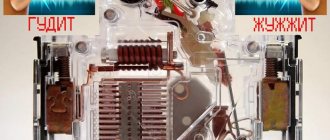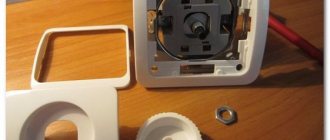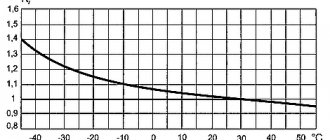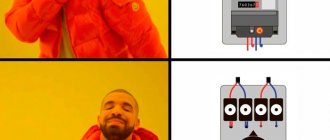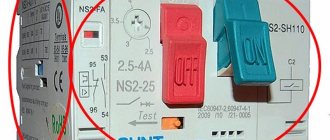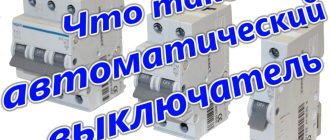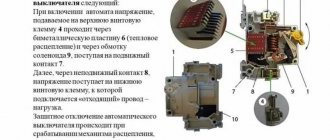Household models have from 1 to 4 pairs of contacts and the corresponding number of poles. Moreover, the scope of their application is directly determined by these parameters. Thus, 2-pole units are installed in a single-phase household network with 220 V at the input, 1-pole units are installed on a separate line, and 3-4-pole units are installed on two-phase circuits designed to operate at 380 V.
The purpose of the device is divided into three main tasks:
This is done manually using a switch on the device body. The function is used when it is necessary to de-energize a separate branch or the entire network of the house in case of repairs, wiring installation and other work that somehow affects the electrical circuit.
As all the work is completed, the lever of the device is simply put into working condition. After this, the supply of electricity to the network is restored.
In this case, the reason why the machine in the panel knocks out is a significant excess of the current in the circuit above the permissible value. A situation arises when a phase and a neutral conductor are connected without load.
As a result, the electromagnetic circuit breaker is instantly activated. In the absence of such a fuse, the electrical wiring, and with it the insulation and all nearby combustible materials, would instantly ignite, which, however, sometimes happens.
The machine will also turn off when the current consumed significantly exceeds the nominal value. This phenomenon occurs when too many electrical appliances are connected to the network, consuming more electricity than allowed by the electrical circuit.
In this case, the opening occurs due to the movement of a heat-sensitive mechanism based on a bimetallic plate. However, unlike the above protective mechanism, this unit does not operate instantly, but as the heating level of the conductor reaches a critical value.
What kind of lighting do you prefer?
Built-in Chandelier
Note! To make sure that during a power outage it was the machine that triggered, you need to inspect it by looking into the distribution panel. When the module is turned off, the tongue of the module is usually directed downwards, and the symbol “O” is visible at its base.
Signs and causes of automatic transmission overheating
Another feature of many hydromechanical automatic transmissions is the high heating of the gearbox oil in the torque converter. This device is actually an automatic transmission clutch, while the torque from the internal combustion engine is transmitted through the transmission fluid.
Expert opinion
Viktor Pavlovich Strebizh, lighting and electrical expert
Any questions ask me, I will help!
On the one hand, the circuit breaker must correspond to the power of the electrical appliance; on the other hand, it must have a small margin so as not to turn off during operation. If there is something you don’t understand, write to me!
Circuit breaker hums
The machine in the panel can only buzz due to an electromagnetic release that protects the line from a short circuit. It consists of an electromagnet with a movable core. The release coil is connected in series with the contacts of the device, and when the current exceeds the protection setting, the moving part of the solenoid is attracted to the stationary part, which leads to the circuit breaker turning off.
The reason why the machine hums in the panel under load is that the current in the network is alternating with a frequency of 50 Hz. This causes the coil and core to vibrate in a manner similar to the hum of mains transformers.
Why does the machine heat up?
The fact is that all household series operate on a thermomagnetic release. Under load, it heats up and as soon as the temperature exceeds the permissible value, the contact plate is deformed and activates the release mechanism, breaking the circuit.
To be fair, it should be said that all machines heat up under load and this is a normal phenomenon. The higher the load, the more the release heats up and the faster the circuit breaks. For example, if a 20A machine starts to pass 23A, then after half an hour it will turn off the network, at 25A this will happen after 5 minutes, and so on. There are several reasons for strong heating:
- Poor condition of contacts - when the contact strip is loosened, the basic throughput deteriorates, causing it to become very hot;
- Wear of the release mechanism - over time, parts wear out, their basic characteristics, including throughput, decrease;
- Poor assembly - low-quality machines, as a rule, have characteristics lower than declared. They do not pass the maximum current for which they are designed, which is why they become very hot;
- High load - the thermal release reacts to the overload protection, and it takes time to heat up, and the plastic case also heats up with it.
Each manufacturer has its own standards for permissible heating temperature, but usually it is from +55°C to +70°C, which is safe for use. You can always check the heating limit in the technical data sheet.
The wiring is getting hot
Please advise on electrical issues. New wiring was done in the house. Input circuit breaker 40A, then a meter, then a wire of about 5 meters to the distribution panel (we bought section 4), then circuit breakers 25A to the sockets. When connecting three 2 KW (6 KW) convectors, you accidentally noticed that the wire from the meter became a little warmer, what should you do? I have plans to install two more convectors + 3 kW, in total with light bulbs there will be 10 kW if everything is connected at the same time. Should I change the wire or install 40A circuit breakers?
Masters online: 173 Orders per week: 1,581 Offers per day: 758
tighten the contacts. The wire frays most likely due to poor contact
Which wire is copper or aluminum? stranded or single-core. If there is only one 25A machine and 6kW in total, then you still need to split it into three 16A each or take 32A
10 kW is approximately 10,000W / 220v = 45 A. If the issue of increasing power is resolved, then. At the entrance there is a gas station 50A (63A is possible), the wire after the meter is at least 6 mm sq. (PV3 10 mm sq. is possible)
Hello. In response to your question, I would like to note that the cable cross-section is 4 square meters. mm. from the meter to the panel is not enough for a given load of 10 kW. The minimum required is 6 sq.mm. And you need to connect no more than 2 convectors per 25 A machine. Therefore, you need to change the input cable from the meter, a 40 A machine has nothing to do with it. This option is for a single-phase network (phase + 0), if you have a 3-phase network, then everything is done correctly and there is no need to change anything, stretch the contacts.
I agree, you can generally install at least 16 square meters of three-wire input cable (no one will say a word to you!), and blame it on drunk electricians from the housing office, but the input circuit breaker needs to be installed at 25-40 amperes. So that the slightest suspicion does not arise on the part of energy accounting. But in Russia, if you can’t, but really want to, then you can. Trust the electrical panel to be assembled by a pro!! It is absolutely dangerous to joke around with electricians with these things. DO NOT USE zero-point tires made in China or Poland (they will get very hot!)! Only Legrand and Schneider Electric.
Incorrect cable cross-section calculation. Change to 6 mm and that's it.
Hello Marina, you need to change the wire from the meter to the panel to a 10mm cross-section. secondly, circuit breakers for 25A sockets are too much; they do not protect your wiring; they will melt faster than the machine will work.
Ten is enough (16 squares, I got carried away)! Sergey, don’t scare Marina - a 3*2.5 cable will hold up, and 25-amp circuit breakers will work ideally (this extreme limit should absolutely never be exceeded). I know from practice that I have not had a single case of sockets burning using the Swedish technology “TREND” (internal sockets) or “QUIK” (external sockets), and only for the screw connection of the socket! What I categorically do not advise is to take sockets from such socket manufacturers as those produced in the countries of Turkey, Ukraine, Belarus, Russia, Spain (there can be no mistake!), and China, of course. Average good quality sockets are from Germany, France, Finland - but again only for a SCREW connection! By the way, I also don’t recommend taking the new model of Swedish “M-TREND” sockets, which already appeared on the Russian market about one and a half to three months ago; they do not have a screw connection of the wire cores. It’s just that self-clamping contacts always burn at high currents. And, secondly, it is better to ideally solder the junction boxes with a conventional welding machine. And then there will be quality like on Soviet submarines!
What to do if vibrations occur?
They often occur when current is applied to a coil or bimetallic strip, which creates an electromagnetic field that acts like an electric magnet on the metal parts inside. Electromagnetic influence provokes vibrations.
Even if the vibrations are almost imperceptible, this is also a malfunction. If you feel a slight tremor when you touch the body with your finger, it means the mechanism inside is defective, which is dangerous for further operation. In this case, it is highly recommended to make a replacement.
Purely theoretically, a circuit breaker can serve you for several more years, but there is no guarantee that the circuit will break during a short circuit. Moreover, constant vibration will over time weaken the connections more, causing the machine to jam, trigger falsely, or even fail. In any case, this is dangerous, so replace it with a new one as soon as possible. The only thing worse than vibrations is crackling. In this case, replacement is needed immediately .
Why is it dangerous?
Excessive heating of electrical devices is dangerous! Especially when it comes to protective devices. Tragic consequences cannot be ruled out:
- Ignition followed by fire.
- Knocks out traffic jams.
- Failure of electrical appliances and equipment.
- Increased risk of electric shock.
Remember: electricity is an extremely dangerous thing and must be taken seriously!
Overload shutdown
First of all, it is necessary to analyze what load was connected to the electrical wiring lines that are connected to this machine. For example, a circuit breaker powers two outlets located in one of the rooms of the apartment. An electric heater was plugged into one outlet, and a vacuum cleaner was plugged into another. In this case, it is necessary to determine whether there was an overcurrent or not. To do this, it is necessary to compare the load current of household electrical appliances with the permissible load current of the circuit breaker (rated current).
The power of the electric heater is 2000 W, and the power of the vacuum cleaner is 1500 W. Having made simple calculations, we obtain the load current of these electrical appliances - 9 and 7 A, respectively, the total load in this case is 16 A. In the apartment panel, to protect the electrical wiring line feeding these sockets, a circuit breaker with a rated current of 16 A is installed.
Based on the fact that the load current does not exceed the rated value for the circuit breaker, we can conclude that there was no overload.
Otherwise, that is, if the load current is greater than the rated current of the circuit breaker, then the automatic shutdown of this device was due to overload.
It should be noted that re-closing the circuit breaker after tripping due to overload can be done a few minutes after it has been turned off. This is due to the fact that the thermal release (that element of the machine that protects against overload) is heated in the activated state, so in order for it to return to its original state it needs to cool down.
When turning off the circuit breaker, you can touch its body. If the housing is warm, this indicates that the thermal release has tripped, that is, a shutdown due to an overload in the electrical network.
If, when you turn on the washing machine, the machine knocks
If, when starting the washing machine or during its operation, the washing was completed, the indicators went out and the lights in the entire apartment turned off, most likely the machine was knocked out. If the washing machine is new and was started for the first time, the wiring is most likely to blame for the disconnection. The reason may lie in the use of low-quality protective devices, or in the use of an RCD of unsuitable capacity.
Doing repairs yourself or installing new RCDs is life-threatening. Unprofessional interference with the electrical network in an apartment can provoke:
- Fire;
- Overheating of wiring;
- Electric shock.
An automatic device can also fail in a situation where, in addition to the washing machine, many other devices were plugged into the outlet, and the network could not withstand such an overload. A new machine can also knock out the machine due to a manufacturing defect. In such a situation, you need to contact the service for warranty repair or replacement of a low-quality washing machine.
Troubleshooting when a circuit breaker trips: algorithm of actions
Without a special reason, the machine will never turn off, which means that there is an emergency situation that caused the circuit to be de-energized. Therefore, before turning it on again, you need to understand why it worked, detect the problem, and fix it. Only after this can the device be put into working condition. Let's look at the two most common triggers and the troubleshooting algorithm.
The machine responsible for the line of sockets knocks out
- Immediately after the protection is triggered, all consumers should be disconnected from the sockets connected to this circuit breaker. It is worth estimating the total load that was connected. There is a possibility that there was an involuntary overload of the line. This must be taken into account, and in the future it is necessary to prevent the simultaneous inclusion of a large number of consumers.
- Turn on the machine; if the protection does not trip again, then most likely there is a line overload or a short circuit in any of the electrical appliances. If the protection device does not turn on, then we can talk about a short circuit either in the socket contacts or in the supply cable itself.
Procedure if the circuit breaker trips without load
- Inspect the sockets for burns; if any, disassemble or replace them.
- A visual inspection did not yield anything, then it is worth assuming that there was an insulation breakdown in the supply wires.
- Possible weak contact or malfunction of the machine itself. After fixing the problem or replacing it, you can try to apply voltage to the line.
Procedure if the machine turns on without load
- Turn off the protection device and connect one of the electrical appliances that was previously connected to the same outlet.
- Turn on the circuit breaker; if it trips again, then this device is faulty. If the operation does not occur, then turn on in turn all the consumers that were working before the protection was turned off. This way you can find a faulty electrical appliance.
Automatic protection is triggered, responsible for the lighting line
A fault in the lighting lines is usually detected when the chandelier is turned on. Everything is immediately clear here, but this situation does not always happen. What to do then? The algorithm of actions is simple and quite accessible to anyone:
- Switch all switch keys to “Off” mode. This de-energizes the phase wire going to the lamps.
- Unscrew the light bulbs, inspect them and the sockets - usually after a short circuit there are traces of soot on the lamp and base. Where such consequences are found, that is where the malfunction occurred. The lamp must be dismantled, the condition of the wiring and socket inspected, and replaced if necessary.
- When nothing suspicious is found on the lamps and sockets, turn on the machine. If it works again, then you should look for a short in the wiring itself. This can happen either in the junction box or anywhere along the line. The second option is that the circuit breaker has turned on, which means we move on.
- Now it’s time to turn on the lighting one by one; if the machine is triggered on some key, then you need to look for a breakdown in the wiring of this lamp.
- If after turning on the switches the protection does not work, you need to screw all the bulbs into place and try to turn on the keys one by one. This will help identify the defective bulb.
When performing any troubleshooting work, be careful and careful, because repeated short circuits are possible. If you have the slightest doubt, it is better to contact electrical specialists who have experience in such work.
Household appliance malfunction
Breakdown of household appliances can also trigger the protective mechanism.
Pay attention to the time at which the machine turns off. If there is a certain pattern and the machine is triggered when a certain action is performed, most likely one of the electrical appliances is to blame. For example, if a power outage occurs while starting a washing machine, electric stove or boiler, turn them off and observe the behavior of the machine. If it does not turn off, look for a breakdown in these household appliances.
Short circuit mode
If the machine is knocked out during a short circuit, this means that an electromagnet has been activated, which serves to instantly break the electrical circuit. In this case, the wiring does not heat up to a dangerous temperature.
When the power contacts open, an electric arc appears. To prevent them from collapsing, a chamber is provided to extinguish the arc. It is made in the form of a lattice of metal plates isolated from each other. On them the arc is crushed and extinguished.
Circuit breaker arcing chamber
Before turning on the machine again after a short circuit has occurred, its causes should be found and eliminated.
Dependence of characteristics of automatic circuit breakers on temperature
Our publications have already described the characteristics of circuit breakers. They have a certain protection response time depending on the load. According to the requirements set out in GOST 50345-2010, the current characteristics of the machines are always presented at an ambient temperature of +30˚С.
Friends, before we find out the reason why the machines turn off in the heat, let’s immediately clarify that in our case they are all working, there is no damage to the wiring, but the machine operates some time after being turned on again.
Electrical circuit breaker malfunction
Your circuit breaker trips periodically. The probable reasons for this are as follows:
- Short circuit in the circuit;
- Network congestion;
- Damage to wires periodically leading to either a short circuit or overload.
First you need to diagnose the electrical network for overload and short circuit. If these faults are not detected, and the machine still turns off, then a malfunction of the circuit breaker itself is very likely.
Why does the neutral wire heat up and how to eliminate overheating?
Heating of an electrical wire is an abnormal phenomenon in the electrical system and is a dangerous, destructive process that leads to accidents and fires. Frequent heating occurs at a point with poor electrical contact due to high contact resistance, or overloading of the conductor with increased load due to an incorrectly selected cable cross-section. But there are cases when the neutral wire heats up more than the phase wire. Within this publication, we will try to understand the reasons for the heating of electrical wires.
The machine crackles under load
The crackling noise heard from the device always indicates the presence of sparks. Most often they occur when the moving and fixed contacts or terminals at the place where the wires are connected are worn out.
If in a working device all connections are tightly adjacent to each other, then when the connection terminals or contact group burn out, the electric current passes through soot, an air gap or point contact of conductive elements.
The flow of current through damaged areas is always accompanied by heating and further destruction of the connections, and if this process goes far enough, then sparks and the accompanying crackling noise are added to it.
Therefore, such a sound indicates the need to immediately turn off and replace the circuit breaker. Otherwise, it is possible not only for the device to fail, but also for it to catch fire and destroy the entire electrical panel.
Why in the heat does the machine not hold the load and turns off?
The circuit breaker protects electrical wiring from overload using thermal control. Exceeding the permissible current value leads to heating of a special element - a bimetallic plate.
It is made of two metal plates welded together that have different thermal properties from each other - different temperature coefficients of linear expansion. Since one side of the plate has a high coefficient, and the other has a low one.
When current flows, the plate begins to heat up; as the temperature rises, the plate bends, which pushes the trigger mechanism of the circuit breaker. The higher the temperature of the bimetallic plate, the greater the angle of its bending, hence the shutdown of the machine. That's why the circuit breaker trips when it's hot.
The machine starts to operate from “thermal protection” when a current from 13% to 45% higher than the rated current passes through it. At this current value, the machine will turn off within 1 hour. This is true at an ambient temperature of +30˚C.
But at a higher ambient temperature, the bimetallic plate is already heated and has a certain bend. Consequently, the plate can heat up to the temperature at which it operates, already at a lower current value in relation to the rated one. Below there is a table of parameters of “hager” brand machines. Dependence of load current and ambient temperature.
Let's take as an example the most common circuit breakers in terms of rated current and VTX - C16. The table data shows why the machine turns off in the heat already at 11 - 12 A, although the maximum response threshold is 16 A. The same is true in switchboards of hot rooms in baths or saunas. Naturally, no one puts them in the steam rooms themselves.
Friends, another example of the dependence of the permissible load on machines on the ambient temperature is a table from the ABB catalog.
Influence of nearby machines
What can affect why the automatic machine works in the heat? There are a large number of them when there are many different circuit breakers nearby. Although this is considered normal for distribution boards and is practiced everywhere. But they will operate at a current exceeding the rated one only with normal ventilation of the air space inside the switchboards.
In such a situation, it is necessary to take into account the mutual influence when there is a thermal effect on machines standing next to each other.
Installed in one row and tightly fitting machines, they transfer some of the heat to each other. This occurs due to the release of heat by the machines under load. Such mutual heating leads to the fact that the bimetallic plate is additionally heated by the neighboring machine. In this case, it is also possible to observe the operation of the machines at a load less than the rated one.
The catalog of modular products from any manufacturer has special coefficients for this case. For example, below I will give a table that shows the correction data for the coefficients of thermal interference of machines.
Remember, at the beginning of the article we stipulated that all characteristics are presented at an air temperature of +30°C. Accordingly, if the temperature rises, the value of the load that the machine can support drops. That's why the circuit breaker trips when it's hot. Therefore, for other temperature values, it is necessary to take into account the coefficients presented above.
What does this knowledge give us for practical application? Let's consider a small example: five C16 circuit breakers are installed in a panel, located on one DIN rail and tightly adjacent to each other. The ambient temperature is +45˚С.
Let's use the tables to find the currents at which they will operate. First, let's take into account the influence of ambient temperature, so a circuit breaker designed for 16 A, at the specified temperature value, has a current threshold of 13 A. That is, it turns out that the thermal receptor of the machine, which should operate at a current of more than 16 A, will begin to operate at a lower current.
Now let’s take into account the coefficient that takes into account the number of nearby machines. In this example it will be equal to 0.9. We get that the thermal protection of C16 automatic machines at a temperature of +45°C and the number of them installed in a row up to 5 pieces will operate at a current of 13x0.9 = 11.7A.
That's why in hot weather the circuit breaker trips when there is practically no load. Unfortunately, few people take these correction factors into account when making calculations.
In winter or cool weather, the picture changes in the opposite direction. At low temperatures, the bimetallic plate will take longer to heat up and, accordingly, the machine may pass a load slightly larger than the rated load.
It is quite a common situation when in the summer you can observe the operation of automatic machines in hot office premises. At the same time, the connected load is not too powerful; as a rule, these are computers, photocopiers and other office equipment.
This happens because the panels for such premises are usually densely staffed (in one row you can see 10, 12 or more machines) and they are also installed in halls and staircases where there is no air conditioning. Practice shows that this is not uncommon.
Rumble in the building
Most often, this problem does not require any action, especially if the circuit breaker is located in a non-residential area. The reason why the machine hums is due to loose fastenings of the electromagnetic release parts, which does not affect the protective properties of the device.
If the sound coming from the case interferes with sleeping or listening to TV, then the device must be replaced. Repair in this situation is only possible by disassembling the case, which is not provided by the manufacturers.
The cable is heating up - what to do, reasons for heating
The zero in the electrical wiring is heating up - what to do?
If the wires in the house get very hot, especially at the places where they are connected, then this is abnormal and indicates serious problems with the electrical wiring. Heating of the wires is associated either with an excessively large load on the electrical wiring or with a poor connection. Much less often problems are observed due to problems with power supply.
Why are Chinese machines so unreliable?
Everyone understands that the only advantage of the “Chinese” is low cost. But it is achieved precisely by saving on materials. Budget Chinese models have cheap everything: plastic, metal, release mechanisms.
The most “trash” models often lack an arc chute. So, under high loads they do not spark, but immediately burn.
All these reductions in price will sooner or later come out sideways. For example, even due to elementary savings on rivets, the strength of the entire structure is lost. As a result, some parts fall off over time and the cocking mechanism weakens. This causes the problems listed above and will require replacement soon.
Electricians often swear at the “Chinese”. In fact, if you take the cheapest ones and take them apart to see what's inside, you'll be surprised how they even work. They usually have a lightweight design, thin springs, power contacts that barely hold, and other obvious problems. This doesn't inspire confidence.
Even worse are Chinese counterfeits of well-known brands, sold below the cost of the originals. Unfortunately, there are a lot of them on the CIS market. It is quite natural that the most popular brand, ABB, has the most counterfeits. This is a Swedish-Swiss manufacturer that produces fairly high-quality machines. Accordingly, you yourself must understand that they will not be too cheap.
To achieve high reliability and quality of releases, more expensive metals are needed: sputtering of silver, gold, etc. In addition, Europeans usually do not skimp on materials. There will definitely be an arc chute there and a heat sink will be made. And all this increases the cost, so there are no good machines cheaper than $3 .
Overload: the machine in the control panel is buzzing
If the voltage stabilizer in the electrical panel is knocked out and knocks out frequently and at approximately the same time, we can most likely say that the reason for the shutdown is a breakdown of an electrical appliance, electric stove, microwave, iron, refrigerator, etc. For example, if you notice that the machine operates when you turn on the washing machine or water heater, turn off this equipment to see and understand how the device behaves without electrical appliances. Is there no shutdown? It is necessary to look for a problem in one of the switched on devices.
A high-quality introductory machine operates completely without sound.
If the AV constantly crackles, hums, buzzes, or turns off, there are 3 reasons:
- Incorrectly selected power;
- Poor quality circuit breaker;
- Unscrupulous manufacturer.
A good machine gun won't be cheap. A good model has a body made of polyamide that is resistant to mechanical damage, and the elements inside include expensive alloys. Often, in order to reduce the price of a device, manufacturers resort to using the cheapest, but least quality materials when creating products.
As a result, such a device works in the most unpredictable way. If there is noise, you need to call an electrician. Playing with electric current is inappropriate; if something worries you, the device gets hot, turns off, buzzes, call an electrician.
Repairs must be carried out at a service center. You can quickly find broken equipment through elimination. Disconnect all plugs from the sockets and connect them one by one. On an electrical appliance that short-circuits when turned on, the circuit breaker will break under an overload. The socket may also be faulty. If all devices are disconnected from the power supply, and the AV knocks out, then the cause may be faulty electrical wiring.
